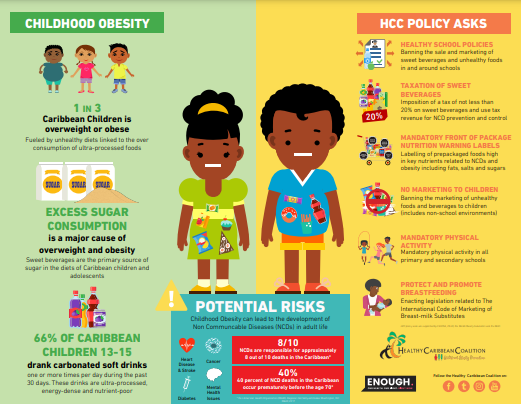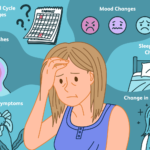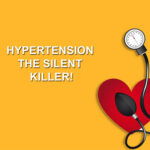
It’s Sunday October 10th, 2021, and among the hot topics in the tropics this past week was the National Budget presentation in the Republic of Trinidad and Tobago. It was entitled “Resilience in the Face of a Global pandemic” and as expected with every budget , it triggered many vibrant discussions! One area in particular struck a chord with healthcare professionals – the removal of Vat and expected price reduction on certain food items- biscuits, cooking oil, canned vegetables, cornflakes, canned fish, canned meat, curry, juice, sausages, ham, ketchup, bottled water and pigtail… it seemed like a counterintuitive move in building COVID-19 resilience and improving the overall health of the population as many of those items are high in salt, fat , sugar and ultra-processed ingredients that are Nutrient poor. This week we look at the forces that nudge us towards unhealthy choices for our families , the sludge that makes it hard to access better ones and why Childhood obesity doesn’t have to be a runaway train…even when the Gut Microbiome is crying out for help!
In last week’s episode we mentioned a very startling statistic- A 2018 cross sectional survey looking at the prevalence of overweight and obese children in ten Caribbean countries found that in Trinidad and Tobago, 51 percent of children ages 6 to 12 were either obese or overweight! This reflected a tremendous increase from 12 percent in 2001. The highest cumulative overweight and obesity percentage was in Dominica with 60.1 percent and the lowest in Grenada with 43 percent. That survey also noted a marked decline in physical activity and a rise in sedentary behaviour. The Healthy Caribbean Coalition (HCC) which was conceived from a Declaration of the Heads of CARICOM in 2007 and officially registered in 2012, launched a 5-year plan spanning 2017 to 2021 to involve over 100 civil society organisations across the Caribbean to tackle the crisis of Childhood Obesity . It called for bold policy and legislative actions to create environments supportive of healthier, happier children and adolescents.
So what progress has there been since the launch of the action plan in 2017?
An interim report by the HCC was compiled in November of 2019 and focused on whether the following four policies had been enacted by any of the CARICOM countries;
1. Government regulation or policy banning or restricting the SALE of Sugar Sweetened beverages (SSBs) in and around schools.
2. Government regulation or policy banning or restricting the SALE of unhealthy foods that are Energy Dense Nutrient Poor (EDNP )or high in fat, sugar and salt (HFSS) in and around all schools.
3. Government regulation of policy banning or restricting the MARKETING of SSBs in and around all schools.
4. Government regulation or policy banning or restricting the MARKETING of unhealthy foods that are EDNP or HFSS in and around all schools.
The sad truth is that out of 20 CARICOM countries , 3 have implemented one policy: the ban on the sale of SSBs in the school environment…the Bahamas, Jamaica and Trinidad and Tobago. Additionally Bahamas was the only country restricting the sale of unhealthy foods that are EDNP in all schools and overall none of the policies enacted apply to vendors near the schools.
The architects of choice are therefore free to use marketing strategies to nudge our children towards unhealthy choices and the channels of change are clogged with the sludge of bureaucracy that makes it harder for advocates to have an impact.
While aggressive advocacy must continue, what are the personal choices that can be made by parents and guardians to fight childhood obesity?
In Episode 2 of our podcast we featured UWI Gut Microbiota Researcher Cerano Da Silva who published a study in 2020 showing that Overweight and Obesity in Children from 2 centers in Trinidad and Tobago was associated with an abundance of a particular bacterial line called Firmicutes and he went on to explain that a diet high in sugar and fats facilitates a higher firmicute population in the gut microbiome. But in this fast-paced environment of impulsive choices how do we steer our families towards eating vegetables, fruits, legumes, nuts and whole grains and break the vicious cycle so that the diversity and richness of our gut bacteria can become the Ninja warriors that help us to fight obesity? How can we make better choices?
According to Nobel Prize winning economist and psychologist , Daniel Kahneman, we must think of our brain as having two systems of processing information to make choices… System 1 is fast, automatic, and highly susceptible to environmental influences; System 2 is slow, logical and reflective, and takes into account long term goals and intentions. When situations are overly complex or when we are faced with time-constraints or other pressures, System 1 processing takes over decision-making. It relies on shortcuts and popular opinion and unfortunately, this can also lead to decisions that are not in our best self-interest. In fact, it is well documented that habitual behaviour is resistant to change without a disruption to the environmental cues that trigger that behaviour.
Here are some tips to override the shortcuts and create an environment that inspires healthy eating in your child:
- Lead by example- children will do as you do not what you say- I know of many busy mothers who skip breakfast while their children are preparing for school in the morning- Please sit and eat breakfast with your child- you will be pleasantly surprised how much more efficient you become and the difference it makes to the habits of your whole family.
- Avoid stocking unhealthy items in the cupboards and Refrigerator where it’s an easy temptation . Out of sight will become out of mind with consistent practice. Additionally avoid stocking an item simply because it was on sale – bear in mind that deals and sales are often on high sugar, nutrient poor items and your dollars are better spent in the fresh produce aisle. What you see for example as 5 packs of cookies for $10 has the hidden price tag of obesity and Diabetes and the loss of quality of life.
- Cook with your children- even when given the smallest of tasks, a child is more likely to consume a healthy , home-cooked meal than to fuss about it and they can prepare healthy versions of their favourite snacks instead of purchasing them from cafeterias and supermarkets.
- Grow food together- even in the smallest of spaces there is room to make gardening a part of your family’s routine and for children to learn a valuable life skill while having something nutritious to freshly harvest and prepare for consumption…whether it’s one head of lettuce or kale or a variety of delicious fibre filled vegetables.
- Don’t give in to the predictable restaurant “Kids menu” of hot dogs, hamburgers, pizza and Macaroni and cheese …allow your child to have a wider choice when you eat out.
- Be vigilant about the sugar content of beverages and the ease of which your child could be consuming loads of empty calories from drinks. The American Heart Association recommends no more than 6tsps of added sugar in the diet of a child and yet the smallest bottle of soft drink in our Caribbean market has 6.5 teaspoons …with the larger versions having 13 to 16 teaspoons.
- Show love without using sweets. Occasional sweet desserts are fine but using sweets at every opportunity to reward a child for finishing his meal or a prize for various achievements, sets a pattern for your child to use sweets as a coping mechanism during stressful times. Your words of encouragement, your hugs and your praise are far more enduring and valuable.
As we end this week’s episode, I want to leave you with a quotation from Theodore Roosevelt,
“Nothing worth having was ever achieved without effort” and though you may feel that the forces are against you in turning your children’s life around, small changes done consistently , day by day, will yield amazing long-term benefits… it is time that we boldly go and chart a new course as we continue our journey to becoming heroes of our own health…




